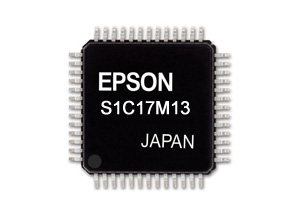Epson starts shipping samples of its S1C17M13 16-bit microcontrol units before volume production next year

16-bit S1C17M13 MCU with integrated Flash memory
Photo by EPSON EUROPE ELECTRONICS GmbH
Seiko Epson Corporation has begun shipping samples of the S1C17M13, a new 16-bit microcontrol unit (MCU) with Flash memory integrated on-chip. This MCU is designed to drive light-emitting diodes (LEDs) at up to 56 mA*. Epson plans to produce 200,000 units per month when volume production beings in March 2017.
Epson has long integrated drivers in its MCUs to control LCDs in applications that use them. Recently, however, there has also been a sharp increase in the number of factory automation products and home appliances that use 7-segment LED displays or LED indicators. Epson anticipates ongoing demand for LEDs as a means for displaying simple information, as LEDs are bright, self-emitting, and easily visible even in dark environments.
On the other hand, LEDs have to be driven at a current of about 10 mA to produce a constant level of brightness. This has made it necessary to add dedicated external driving circuits to today’s low-voltage, low-power MCUs. Moreover, users have had to develop their own control software and embed it in an MCU to achieve efficient multiple-digit segment displays. LEDs are simple, but they require more external driving components than LCDs. Users have thus had to spend considerable time and money developing LED software-as much if not more than for LCDs. Reducing users’ costs and development times has thus been an issue.
The S1C17M13, Epson’s first MCU for LED display applications, is ideally engineered to solve this issue. This product operates at voltages ranging from 1.8 V to 5.5 V and readily supports the 5 V needed for most factory automation products. The new MCU has five pins that can output up to 56 mA*. By using these high-output pins as common pins in combination with an additional eight other segment pins, users can drive a segment LED display with up to 8 segments x 5 common pins without the use of external transistors on the common lines.
In addition, the MCU has an integrated hardware controller that supports dynamic lighting control. Customers can use a simple software setting to select any segment (LED) they wish to light up. They can fine-tune the lighting interval and adjust the brightness to any of four levels. These new features will help users reduce the cost of their products as well as their total development times.
Epson also plans to commercialize a derivative product in the series (the S1C17M12) that does not include the 12-bit AD converter. Two types of evaluation boards are also available for the new product.
For more information, please visit http://www.epson-electronics.de.
News Categories
- » NEWS HOME
- » Automation & Robotics
- » Industry 4.0
- » Material Handling
- » Sensors
- » Quality & Testing
- » Machine Vision
- » Laser & Optics
- » Metalworking
- » Motion Control & Drives
- » Hydraulics & Pneumatics
- » Process Industry
- » Renewable Energy
- » Agriculture
- » Home & Office Furniture
- » Environmental Tech




